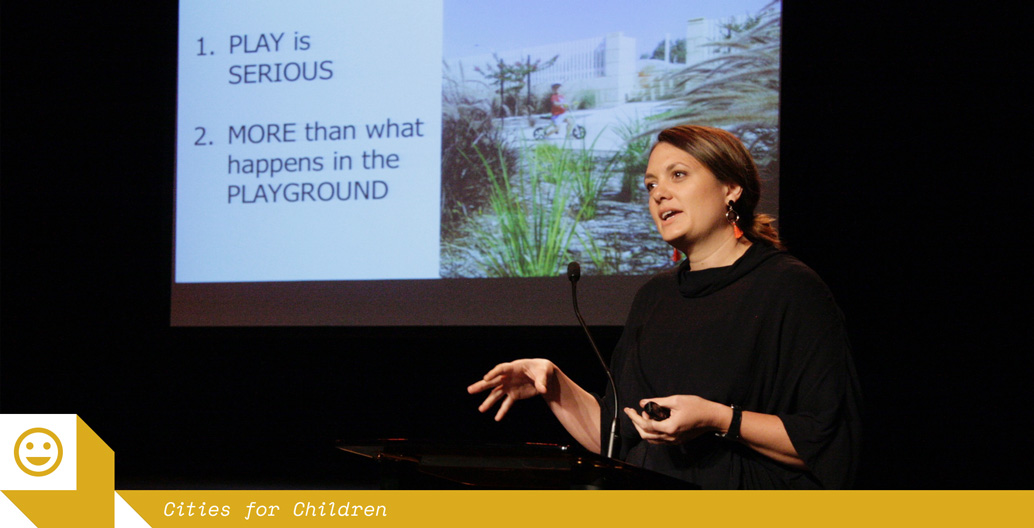
To make cities for children, we’ll have to overcome our culture of fear
A panel of experts discuss the problem of Australia’s child-hostile cities, and what might be done to address it.
As the culmination of our Cities for Children series, Foreground convened a public forum on 28 July at Sydney’s Lendlease Darling Quarter Theatre to discuss the problem of our increasingly child-hostile urban environments. Speakers on the day included Karen Malone, Professor of Sustainability and director of the Centre for Educational Research at Western Sydney University, Councillor Jess Miller of the City of Sydney, Shea Hatch, landscape architect at the Fremantle-based practice UDLA, and Scott Hawken, an urban designer and landscape architect with a special interest in how digital technologies are affecting our cities. What follows is an abridged transcript of the panel discussion that closed that event, a full recording of which can be found above.
Maitiú Ward: Everybody’s been very careful today to talk to this problem of child hostile cities as being quite a complex one. We’ve got cultural issues related to fear and issues related to the design of the spaces. But then I can’t help but think that planning seems to be the biggest problem of all. Would that be a fair descriptor do you think Karen, or am I drawing a long bow?
Karen Miller: My view is that planning is one of the pieces in the puzzle, but actually it’s a cultural shift too that we need to make, because the greatest lobbyer we have is our community. And so the demands for something different need to come from them. We’ve had parents being told it is unhealthy for children to be inside, they’re living sedentary lifestyles, they’re going to be the most likely generation to go through heart disease and all sorts of things in the future. So there’s real pressure. Yes, we need to be thinking differently about our children, but then we don’t really have the social support to enable them to be different. We’ve developed this cultural norm around what parenting is about and it’s based on a model of eternal vigilance; you are constantly 100% responsible for your children, no one else takes responsibility.
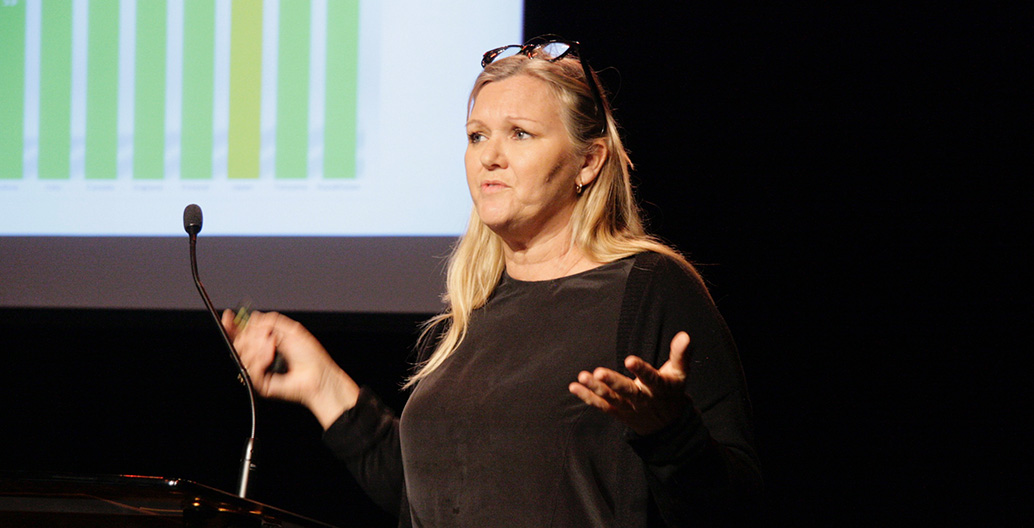
Karen Malone presents at the Cities for Children forum.
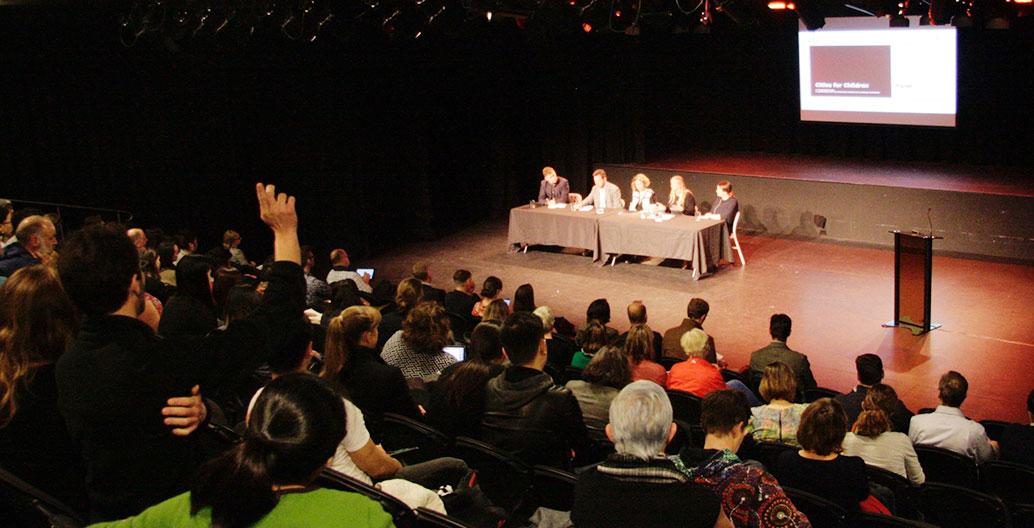
The panel at the Cities for Children forum takes questions from the crowd.
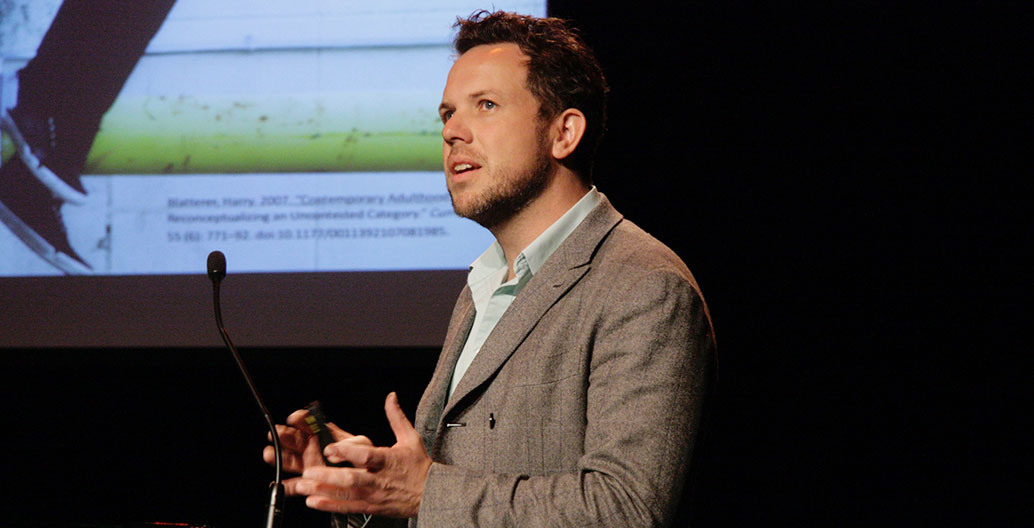
Scott Hawken presents at the Cities for Children forum.
This notion of eternal vigilance as a parenting model puts huge pressure on parents, and the fear that they might make a mistake or do something that might put their child at risk undermines all of the decisions that they make. If you’ve ever read Peter Pierce’s book The Country of Lost Children, he says this cultural norm in Australian society goes back to colonisation, where children were constantly lost in the landscape of Australia, and we’ve carried this eternal fear of children moving too far. We’ve retreated so much into the internal spaces of our houses that it’s almost becoming difficult to imagine how we’re going to encourage parents to let go and come back out.
MW : So how do we begin to combat that Picnic at Hanging Rock culture? I mean it seems like an enormous challenge…
KM: I think we’re seeing it. Even this idea of the bespoke hipster movement is actually a shift in the right direction; at least there is an understanding that there’s a quality of life that can be part of a city lifestyle that includes being out and about. But it’s chicken and egg: do we create the child-friendly spaces and hope the children come, or do we get the children out and then build the spaces to accommodate them? There’s a lot of building that’s been done around trying to create great destination sites. But unless the parents get in the car or go with them, kids can’t get there. So in a sense that everyday-ness of neighbourhood pocket parks, which were part of our childhood experiences going back 30 or 40 years ago, a lot of those have been lost because of intense housing. But also because people didn’t use them, so councils pulled them down.
MW: Shea, do you think we should build first and let them come?
Shea Hatch: No, I think it’s about listening to the community that’s there. We were talking a lot about authentic cities and how you create them, but we need to take a step back and realise that a lot of the time there’s an authentic community that already exists. And until you understand what their drivers are and what their interests are, and that it’s going to be different to the next community, then we really can’t come in and have the “Designer is God” approach to cities. That’s obviously very difficult when you’re looking at a broader policy scale. And I think that for those reasons policy should have those supporting mechanisms, which is what I’ve researched.
An example on a really small scale in Perth recently: there was a duplex situation where two kids had moved in and were bouncing a basketball in the common space – the mom said not much at all, the neighbour said all the time, so I’m guessing somewhere in the middle there. But the neighbour complained to the strata, and the strata banned children doing that. Obviously that’s a really poor outcome for both parties, but in something that’s as simple as three lots that have been subdivided in a semi-suburban place in Perth you’ve got an outcome that’s not meeting anyone’s requirements in that space. So I think that it is a responsibility at all levels, not just planning.
MW: How do those kinds of conflict translate Jess to the neighbourhood scale, or citywide scale for you guys? How do you balance all of these competing objectives?
Jess Miller: The hard thing is when you introduce a level of politics into the whole equation. With the bicycle and active transport stuff, I’m an independent and aligned with Clover Moore, so we’re connected by these shared values. But then the community through the resident action groups, all they have to do is pick another one of the other councillors on the other side of the table and say, “This is an outrage”. And then all of a sudden you’ve got Christine Forster with her hand up saying, “Parking is a non-renewable resource and we must protect it”. And that plays out in the media, and so it adds a level of complexity that’s very adversarial. It’s not the way we would like to do things; it polarises the conversation into an either/or.
We do respect the fact that when we’re building a new cycleway people are going to be upset about the loss of parking. And if we can ameliorate that we will, but there have to be negotiations and compromises so we can take horizontal parking to parallel. But we also have to make sure that RMS [Roads and Maritime Services] are happy with the sightlines, and then we have to make sure that we’re not losing any trees and that there’s adequate pedestrian safety. So it’s a really complicated and layered approach, where you’re trying to balance the interests of many people. There’s a frequent flyer list of people that email you all the time.
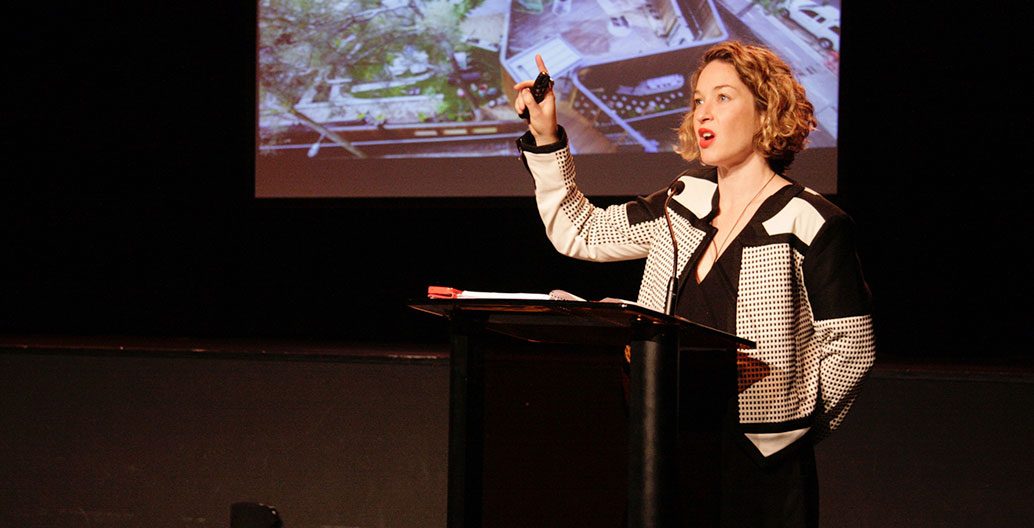
Councillor Jess Miller from the City of Sydney presents at the Cities for Children forum.
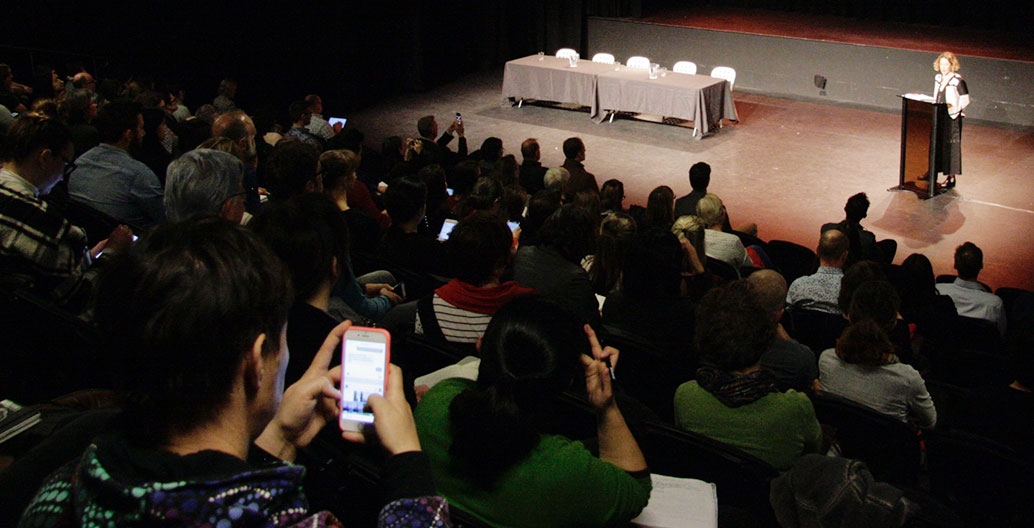
The crowd at the Foreground Cities for Children forum.
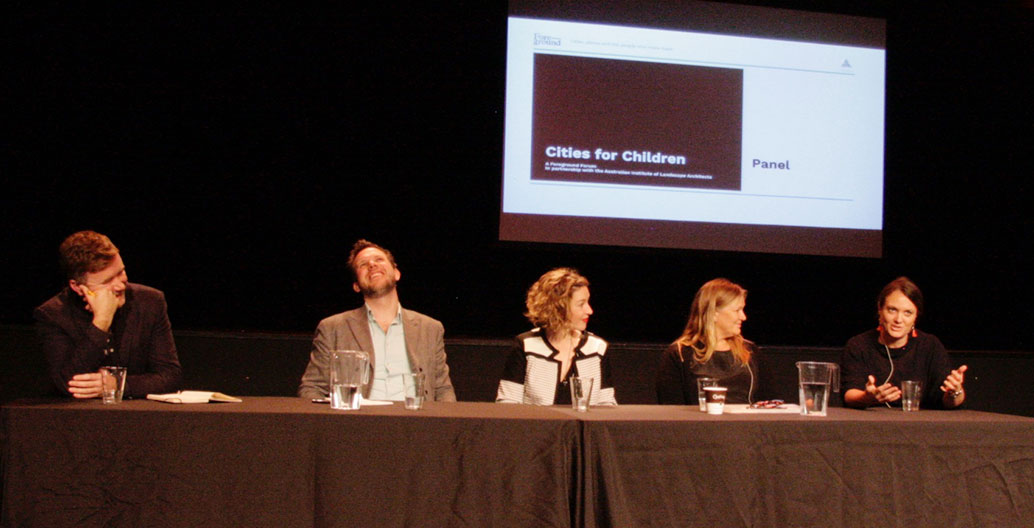
The Cities for Children panel responds to a question from the crowd.
MW: So bike lanes are one thing, but I would have thought that even the Daily Tele wouldn’t be mean enough to have a go at playgrounds and making amenity for kids in our cities. You mentioned earlier though that people hate children playing. Is that generally widespread in the electorate?
JM: No, I don’t think it is, I don’t think it’s widespread. I think that there is just a very vocal minority, and don’t put it past the Tele. If Clover Moore supports it, that’s basically Clover-bait you know. It’s about these narratives that manifest, and I think sometimes the narratives are quite interesting because they have a perverse effect. So the Daily Tele’s trying to vilify Clover as the crazy bike lady who wants to put kids parks in the Cross, how dare she. They feed off whipping up this atmosphere of fear, because it’s a good story.
The perverse effect of that is it really works for us sometimes, because then a whole lot of very rational, sensible people from the community who otherwise wouldn’t say anything, put their hands up to say, “well actually I think it’s a great idea”.
MW: It kind of feels from that perspective that the biggest challenge is building that conversation around some of these ideas, trying to keep that conversation as diverse as possible. Scott, we’ve talked a little bit about digital tools as a means of engaging people virtually. Are we seeing any kind of applications of the tools in local planning or urban design that are broadening that conversation?
Scott Hawken: I think in Sydney we’ve got a way to travel in terms of those digital tools, but there have been some applications that have been developed to really put the facts on the table. Sometimes this adversarial culture that Jess is talking about is really exacerbated by fear and mistrust of the system. And so, if a system can become in a way turned inside out and more transparent, and people have a better understanding of what’s happening, I think argument, the actual data and the facts can help. And so there have been some applications for that – one developed by some colleagues called Urban Pinboard, which has launched in Parramatta. I don’t know what impact it’s had at this point, but it’s quite new. And then there was the application that I mentioned before, Safetipin, which was created in India and which we’re looking to apply at UNSW to really make it safer. I don’t know if the audience is aware, but earlier in the week there’s been a lot of coverage of sexual misconduct and rape allegations that haven’t been dealt with fairly on-campus. I think the technology can make this more transparent by taking that power and shifting it away from that centralised control and opening the conversation up.
The other way that technology can help I think is that it’s a very siloed approach in planning, so RMS they do their job well, but unfortunately their job’s only one thing, to get from A to B. And they don’t really think about the damage that’s done to a city getting from A to B, and whether it’s worthwhile to get from A to B in the first place. So just to broaden the conversation is essential. There are various platforms that can do that – one other one is Geodesign, which we’re trying to get up at the moment within the city.
MW: Geodesign?
ScH: One of the creators was Carl Steinitz from Harvard. It’s about coming up with one design but with many voices. It’s not design by a committee, which could be a fair perception, but getting the best outcome through collaboration.
MW : Shea, you’ve worked a lot with collaborative design, with young children particularly. Jess mentioned earlier the genuine risk that [by consulting with children] we might have playgrounds populated by nothing but computer screens. How do you manage that process so that you get an outcome that’s viable and fit for purpose?
SH: Yeah, I still haven’t got approval from a council yet to put in a zip-line that has lasers and shoot water at you, which is what I’m really trying for. To give an example that’s really heartbreaking, I was talking to a group of kids, and I said, “What do you think would make you want to stay in a playground longer?” And they said, “Toilet blocks”, and I was like, “Okay, why is that?”, “Mom and dad prefer it, we only go to parks with toilet blocks”. I’m like, “That’s good, what else?” “Wi-Fi”. I said, “Why do you want Wi-Fi?” and they said, “Oh, because that means that mom and dad will stay longer”. As a joke, whenever someone asks what you need to make a good playground, I go: a coffee shop nearby and Wi-Fi. That’s really sad, but I think when you’re talking to kids, it’s important that when you speak to them, they are so used to giving the answer that they think you want to hear, that you really have to be careful in how you word it.
That’s why doing things like drawings, sculptures, going for walks and talking about “When did you last have a really good time? What did you do on that holiday?” It draws out responses and then even if it’s something as crazy as a zip-line with lasers, then break that down into: well there’s movement, and they want something that’s fast and exciting and that they haven’t seen before. The most important part is doing that initial consultancy, getting some ideas and then going back with options and asking, “Did we get it right?” A lot of the projects we worked on with schools, so we just left it with them to build themselves and the parents did it, which has its own benefits.
“When the kids were involved in that process, it was a much better outcome” –Shea Hatch, @UDLAStudio
ScH: Shea, do you ever get the children that you work with to design the parks themselves?
SH: When I was with Nature Play that was pretty much what we did. So I didn’t work as a landscape architect there, they called me a play facilitator, which was for lack of anything better that we could come up with. What was getting frustrating for us in the Perth market is that everyone had heard about Nature Play but were just going out and spending $100,000 on a playground that was effectively a plastic fantastic playground, but made of wood. That’s a horrible outcome for a school because they have limited resources, so my role was to go in and say, “Okay, well what are the play outcomes that we want to achieve? How can you do that yourself?” And maybe we could get something similar for five grand, then talking more about how you can do that within the policy, and the requirements from the safety point of view. But that’s all empowered them then to do it themselves, and the kids were always involved in that process, or at least, when they were it was a much better outcome.
ScH: So they’re actually making the park themselves as well?
SH: Physically yeah.
ScH: With chalk and other things.
SH: With hammers and spades and nails and saws. They love building stuff.
MW: How does fear play into that process, particularly parental fear around risk and danger. Is it an easy sell?
SH: For the parents?
MW: Yeah, to give the kids a hammer?
SH: There’s only so much damage you can do with a hammer until someone stops you. They’re not power saws – there’s not too much you can do with a handsaw. It’s probably a very biased group – they’re bringing their kids to a Nature Play event, so obviously they’re well into that. But I think that the second that you watch your child do something and realise that they’re capable, the parents were getting much more out of it than the kids were, from understanding their capabilities.
KM: I think this goes back to cultural norms, too; we have all these assumptions of what children are capable of doing or not doing. Take the example of Japan. Japan has 270 adventure playgrounds in Tokyo city. And in those adventure playgrounds, yes there’s some structure, but the majority of it is an adventure playground, a space that children are inventing and creating themselves. They have sheds with ropes and mattresses and little fires where you can cook something, there are some hammers and nails. A couple of old guys will come and sit with the kids and help them build things. You know so it’s about the materials that might be there, and then kids are designing and working and doing things themselves.
Overcoming the risk and safety issues has often been about the commitment that parents make to the desire for kids to have those experiences. So the willingness to say, okay there’s a chance they might step on a nail, they might fall off the flying fox and break an arm. But the benefits of them having those experiences close to where they live outweigh those consequences and the possibility of damage. In Australia, why don’t we have a culture of those things? I think they’re the questions we need to ask. We keep building these very structured parks, when we could do a lot more with looser materials than the multimillion-dollar parks that we keep investing huge amounts of money in.
SH: I was going to say, please look up the documentary The Land.
KM: Yeah, it’s amazing.
SH: So amazing it will blow your mind. There’s a playground that you can light fires in as a kid, that’s the dream.
ScH: That’s really about getting back to nature. I know I’m the digital advocate here, but there is such a thing as too much, and there has to be those moments where you switch off. And the best way to do that is nature, but I don’t know how much nature children are getting these days.
SH: Aldi recently put out an exercise bike for children, and it has a screen in front of it for them to put their iPad on. I thought it was a joke at first.
KM: We can’t make playgrounds benign and boring – would you want to play inside with your iPad, or go to local playground that’s really boring? Kids want excitement, they want things to be interesting, they want to build, invent, play in ways that will extend their thinking. As in opposition to the digital stuff that might be more sedentary in mode. So they want both of these things, but if you don’t give them great spaces to play, then they’re not going to choose that because they have the other.
JM: It’s also got to cater the parents as well.
MW : I was going to say, Jess, can you imagine an adventure playground with fire and hammers and nails getting off the ground in the City of Sydney?
JM: I’d try and advocate for it. But this is kind of ironic, because I think the reason that Clover got into politics in the first place is because she lived in Redfern with young kids and they were told they couldn’t have grass at the pocket park because you couldn’t sweep the glass off it. We have the responsibility as council to keep places clean and all that sort of stuff. But my council brain goes, “Oh my God we would get sued.” That definitely plays to that cultural idea and being able to quantify the benefit versus risk.
But what you said about parents really resonated with me, because I’ve got a five-year-old and you spend so much time in the park and it gets so boring. I used to have a quota of pushes in my arm, and if we reached the quota of 50, it was like “I can’t push you on the swing anymore.” Parenting young kids is pretty repetitious and boring. It would be amazing to see designs where you could incorporate those interactions between parents and children. If it was a park where mom can do a quick workout while playing with the kids that would be awesome. But unfortunately a lot of the equipment is a very passive and disconnected experience for parents.
ScH: I think those spaces already exist in the city, but we just have to tweak them – they’re the streets. It’s just about using the existing spaces in a more imaginative and intergenerational way.


